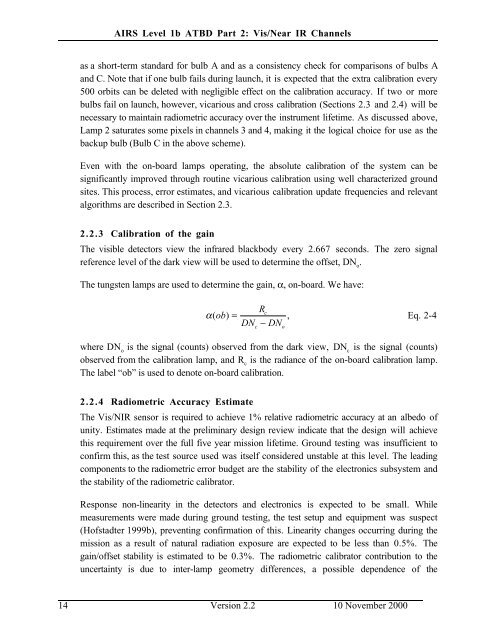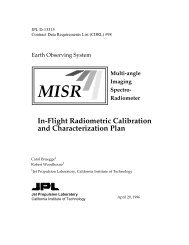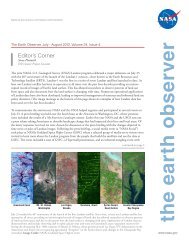AIRS Level 1B Visible/Near-Infrared Channels ATBD - NASA's Earth ...
AIRS Level 1B Visible/Near-Infrared Channels ATBD - NASA's Earth ...
AIRS Level 1B Visible/Near-Infrared Channels ATBD - NASA's Earth ...
Create successful ePaper yourself
Turn your PDF publications into a flip-book with our unique Google optimized e-Paper software.
<strong>AIRS</strong> <strong>Level</strong> 1b <strong>ATBD</strong> Part 2: Vis/<strong>Near</strong> IR <strong>Channels</strong><br />
as a short-term standard for bulb A and as a consistency check for comparisons of bulbs A<br />
and C. Note that if one bulb fails during launch, it is expected that the extra calibration every<br />
500 orbits can be deleted with negligible effect on the calibration accuracy. If two or more<br />
bulbs fail on launch, however, vicarious and cross calibration (Sections 2.3 and 2.4) will be<br />
necessary to maintain radiometric accuracy over the instrument lifetime. As discussed above,<br />
Lamp 2 saturates some pixels in channels 3 and 4, making it the logical choice for use as the<br />
backup bulb (Bulb C in the above scheme).<br />
Even with the on-board lamps operating, the absolute calibration of the system can be<br />
significantly improved through routine vicarious calibration using well characterized ground<br />
sites. This process, error estimates, and vicarious calibration update frequencies and relevant<br />
algorithms are described in Section 2.3.<br />
2.2.3 Calibration of the gain<br />
The visible detectors view the infrared blackbody every 2.667 seconds. The zero signal<br />
reference level of the dark view will be used to determine the offset, DN o<br />
.<br />
The tungsten lamps are used to determine the gain, α, on-board. We have:<br />
α( ob)<br />
=<br />
Rc<br />
, Eq. 2-4<br />
DN − DN<br />
c<br />
o<br />
where DN o<br />
is the signal (counts) observed from the dark view, DN c<br />
is the signal (counts)<br />
observed from the calibration lamp, and R c<br />
is the radiance of the on-board calibration lamp.<br />
The label “ob” is used to denote on-board calibration.<br />
2.2.4 Radiometric Accuracy Estimate<br />
The Vis/NIR sensor is required to achieve 1% relative radiometric accuracy at an albedo of<br />
unity. Estimates made at the preliminary design review indicate that the design will achieve<br />
this requirement over the full five year mission lifetime. Ground testing was insufficient to<br />
confirm this, as the test source used was itself considered unstable at this level. The leading<br />
components to the radiometric error budget are the stability of the electronics subsystem and<br />
the stability of the radiometric calibrator.<br />
Response non-linearity in the detectors and electronics is expected to be small. While<br />
measurements were made during ground testing, the test setup and equipment was suspect<br />
(Hofstadter 1999b), preventing confirmation of this. Linearity changes occurring during the<br />
mission as a result of natural radiation exposure are expected to be less than 0.5%. The<br />
gain/offset stability is estimated to be 0.3%. The radiometric calibrator contribution to the<br />
uncertainty is due to inter-lamp geometry differences, a possible dependence of the<br />
14 Version 2.2 10 November 2000







